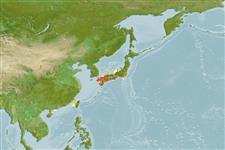Common names from other countries
>
Eupercaria/misc (Various families in series Eupercaria) >
Gerreidae (Mojarras)
Etymology: Gerres: Latin, gerres = a kind of anchovies; cited by Plinius; akazakii: Named for Dr. Masato Akazaki..
Environment: milieu / climate zone / depth range / distribution range
экология
морской; солоноватоводный демерсальный; пределы глубины 2 - 3 m (Ref. 58476). Subtropical
Northwest Pacific: likely to be endemic in Japan.
Size / Вес / Возраст
Maturity: Lm ? range ? - ? cm
Max length : 16.9 cm SL самец/пол неопределен; (Ref. 58476)
Краткое описание
определительные ключи | морфология | морфометрия
колючие лучи спинного плавника (общее число) : 10; членистые (мягкие) лучи спинного плавника (общее число) : 9; колючие лучи анального плавника: 3; членистые (мягкие) лучи анального плавника: 7.
Known to inhabit the vicinity of river mouth basins, which may be considered strongly related to a minimum winter sea temperature of 16°C (less than 100 m depth). Specimens were collected in inlet basins, river mouth basins, or on shallow sandy bottoms strongly affected by freshwater from nearby river mouths. However, this species rarely occurs in the shallow coastal area with almost no freshwater effect. One specimen (MUFS 9584, 135 mm SL, 3 July 1993), had a clearly matured or water-hardened (transparent) egg, giving an indication of the spawning season of the species (Ref. 58476).
Life cycle and mating behavior
Maturities | размножение | Spawnings | Egg(s) | Fecundities | личинки
Iwatsuki, Y., S. Kimura and T. Yoshino, 2007. A review of the Gerres subfasciatus complex from the Indo-west Pacific, with three new species (Perciformes: Gerridae). Ichthyol. Res. 54(2):168-185. (Ref. 58476)
Статус Красного Списка МСОП (Ref. 130435)
CITES (Ref. 128078)
Not Evaluated
Использование человеком
дополнительная информация
инструменты
Специальные отчеты
Скачать в формате XML
ресурсы в Интернет
Estimates based on models
Preferred temperature (Ref.
115969): 20.2 - 24.3, mean 21.6 (based on 90 cells).
Phylogenetic diversity index (Ref.
82804): PD
50 = 0.5000 [Uniqueness, from 0.5 = low to 2.0 = high].
Bayesian length-weight: a=0.01413 (0.00602 - 0.03315), b=3.04 (2.86 - 3.22), in cm Total Length, based on LWR estimates for this Genus-body shape (Ref.
93245).
Trophic level (Ref.
69278): 3.3 ±0.3 se; based on size and trophs of closest relatives
устойчивость к внешним воздействиям (Ref.
120179): высокий, минимальное время удвоения популяции до 15 месяцев (Preliminary K or Fecundity.).
Fishing Vulnerability (Ref.
59153): Low vulnerability (11 of 100).
